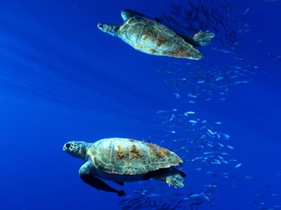1.Bluefin Tuna

The most valuable fish in the world are in great danger. According to Oceana, the International Commission for the Conservation of Atlantic Tunas (ICCAT) estimates that as few as 25,000 individual mature bluefin tuna remain.
Why bluefin tuna are in trouble: The greatest enemy of tuna is overfishing, overfishing, overfishing, as well as tuna ranching (when tuna are caught alive and fed for months before being
2.Cape Penguin

Cape penguins are also called jackass penguins, because of their call, which sounds like a donkey neighing. This penguin breeds only in Africa.
Why are cape penguins and other sea birds in danger? Loss of nesting sites, oil spills and food loss due to overfishing are a major threat to sea birds.
3.Coral

Don't forget, coral is a sea animal too. In fact they are an important part of the ocean's ecosystem. Coral gives other sea creatures protection and a place to breed and spawn. Coral also helps people out too -- coral has many pharmaceutical properties.
Why coral is in trouble: This fundamental part of the ocean is incredibly sensitive; ocean acidification and bottom trawling commercial fishing are its major threats.
4.Gray Whale

Unique among whales for their dorsal humps (instead of fins), these 50-foot whales are also notable for their moans, growls, knocks and other distinctive vocalizations. While gray whales near Baja California are thought to be friendly, the species is known worldwide for the fierceness with which mothers defend their calves.
Why gray whales are in trouble: Centuries of overfishing have left one population extinct (North Atlantic) and one critically endangered (Western North Pacific). The good news is that fishing restrictions have allowed the third population, in the Eastern North Pacific, to rebound to the point that it was removed from the U.S. Endangered Species List in 1994.
5.Hector's Dolphin

With just 7,400 individuals believed to be alive in the coastal waters off New Zealand, Hector's dolphin is listed by the IUCN as a "red list" endangered species.
Why Hector's dolphins are in trouble: Bycatch, pollutants and boat disturbance.
6.Humphead Wrasse

While it is also known as the Napolean fish, the Humphead wrasse gets its name from an obvious anatomic feature. It's one of the largest coral reef fishes and can be found on reefs throughout the islands of the Pacific and parts of the Indian Ocean. Oh, and it's hermaphroditic, changing from one sex to the other during the course of its maturation.
Why Humphead wrasses are in trouble: Because the fish takes a long time to mature, it's relatively rare to begin with, and it's easy for fishermen to predict where it spawns, overfishing has been a problem for generations.
7.Krill

This tiny creature plays an important role in the ocean's ecosystem. Krill is the main food source for many marine animals, from salmon to blue whales.
Why krill is in trouble: Because krill are a food source for so many marine animals, they are harvested to feed farmed fish.
8.Loggerhead Sea Turtle

Loggerhead sea turtles, like all six types of sea turtles, are listed as threatened with extinction under the Endangered Species Act.
Why turtles are in trouble: Fishing gear is the sea turtles' worst enemy, but loss of habitat and climate change also play a role in putting these species in jeopardy.
9.Manatees

Resembling land mammals as much as any sea creature, the manatee is a gentle giant vegetarian. The world's largest population of manatee is in Florida, but even there, fewer than 3,000 individuals are in existence.
Why manatees are in trouble: In addition to passing problems like the 2010 winter freeze that harmed manatees and other sea creatures in Florida, toxic algae (caused by human pollution), loss of habitat and boating collisions.
10.Mediterranean Monk Seal

One of the six most endangered mammals in the world, according to WWF, the Mediterranean Monk Seal once ranged from Portugal to Senegal. Today just 500 remain in isolated clusters.
Why seals are in trouble: Hunting, habitat destruction, pollution, depletion of fish stocks and competition with fishermen all factored into the decline of the Mediterranean Monk Seal. Other seals, however, may be threatened by global warming, as Arctic and Antarctic habitats change rapidly.
11.Chinook Salmon

Salmon, the most popular seafood and sport fish in the world, are in danger. Wild salmon sales support many communities around the world, but these fish need clean rivers and oceans to survive.
Why are Chinook salmon in trouble? Chinook salmon from Alaska to California are in decline and pollution, global warming and bycatch are to blame.
Take action: Visit Oceana and learn more about Chinook salmon and other salmon species.
12.Vaquita

This small porpoise is one of the most endangered marine mammals, with fewer than 600 individuals left in Mexico's Gulf of California.
Why Vaquitas are in trouble: Already in decline because the damming of the Colorado River has destroyed parts of their habitat, Vaquitas are also threatened by the gill nets used to catch fish. They are often killed unintentionally as bycatch.
13.Southern Sea Otter

With the densest fur on the planet, sea otters survive in cold waters without the blubber layer that insulates other marine mammals. They also need to eat a lot to keep warm: They consume up to a quarter of their body weight every day. While Northern Sea Otters, found off the West Coast of the U.S. from Alaska to Washington, have a robust population of roughly 77,000, fewer than 3,000 Southern Sea Otters live off the coast of California.
Why sea otters are in trouble: The biggest threats to sea otters came in the past, when the fur trade caused their numbers to drop from more than 1 million to fewer than 2,000. Ongoing threats include oil spills, habitat loss, food limitations, disease, entanglement in fishing gear and conflict with shellfish fisheries (since otters like mussels, clams, crabs and other seafood that humans enjoy, too).

No comments:
Post a Comment